COURAGE and PEACE and Mr. Carter's Bull
Courage and Peace
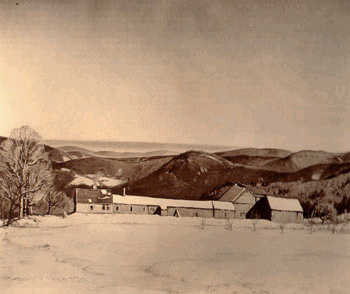
Courage and Peace (36x42)
"Painted in 1932 or 3. Carter's farm in Buckland on Town Farm Hill. Later made a chalk drawing of same thing, owned by Miss Elise Biddle Robinson of Philadelphia (now Mrs. Harold Paumgarten). Also made a 25 x 30 canvas owned by Harold W. Grieve, noted decorator of West Hollywood, California. Made Peace and Courage from larger canvas. (Courage and Peace was) bought and owned by Mrs. William H. Moore, 4 East 54th St., N.Y. City, from Macbeth Exhibition in 1935."
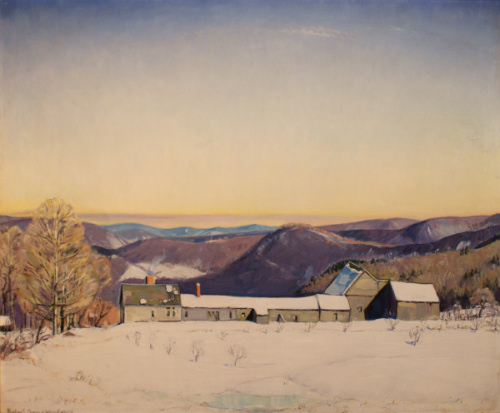
Peace and Courage (25x30)
The Woodward diary does not mention a painting titled "Shelburne Falls in Winter." I would surmise that the painting was unnamed when Mr. Grieve took it back to California and that he himself gave it that name. The painting is of the old Carter farm on Avery Road in Buckland Center. Today the house has little resemblance to the old original farmhouse and barns because of a disastrous fire which occurred in about 1938. The home was then occupied by David Carter and his wife, Caroline, and David's elderly mother. David's father had earlier died having been gored by his bull.
I recently had a visit with Francis Wilder, now 85 years old and very ill with colon cancer, who lives in the next farm up Avery Road on the right. I showed him the picture of the painting downloaded off the internet and he confirmed that it was of the Carter farm, that it had burned in the late 30s and that he was partially responsible for its burning down. It seems that he and his mother the evening of the fire were driving up Charlemont Road after a meeting at the Buckland Grange when they came upon Dr. George (Greaves) walking home and who, as usual, was smoking his pipe. Dr. George was a physician who moved to Buckland from England in the early 1900s with his brother who was also a physician. I have forgotten the name of the brother, but he did have an office in the tenement building located close to the Buckland Public Library. The tenement building burned down in 1962. Dr. George, to my knowledge, never did practice medicine; in fact, there apparently was some question as to whether he was actually a real doctor.
As a kid I can remember him walking down Charlemont Road to the Post Office to get his mail. He lived in a little house, the first one on the right out in the woods, off Avery Road. He always carried an umbrella and wore spats. When Dr. George was old, he moved up to live with the Carters, who in those days took in boarders. He had a room on the second floor at the rear of the main Carter house where it was connected to a long series of barn buildings. Francis and his mother dropped him off at the Carters, still smoking his pipe, and they went on up the road. Being late they went right to bed. Francis slept in a bedroom at the front of the Wilder house, and before he got to sleep remembers hearing the elder Mrs. Carter down the road screaming the house is on fire! Neighbors from all around were called and hurried to help out. In those days there were no fire ponds so using buckets, under the direction of my uncle Dunk (Earl Purinton) who was the fire chief in Buckland at the time, they ran to near-by brooks and carried water to the house, splashing it on the burning fire at the rear of the house.
It was determined almost immediately that Dr. George had knocked out his pipe on the bottom of the stair railing leading up to his room. The ashes had landed on papers laying on the stairway, starting up the fire. The bucket brigade was able to keep the fire from spreading back into the house. According to Francis, it was fortunate that the wind that evening was in the right direction, carrying the fire along the series of barns down to the very last one which somehow got spared. A second unattached barn was unaffected, but some years later this one was taken down.
Francis also related that David Carter was a business man and in those days, during World War II, bought up a lot of things which were in short supply, stocking them in his cellar, which he could later re-sell. Included in his cellar stock, according to Francis, were numerous automobile tires and ladies stockings among other things. As the fire was in progress, David was busy carrying many of these items out of the cellar to safety. As it turned out only the very end of the house was damaged. All of the barns were lost except the two large ones out at the end of the series. The farm was built, as were many in those days, connected from the house all the way out to a brook so that in winter water could be easily obtained without going out-of-doors. The fire apparently occurred in 1938 or 9. At that time I was living in Buckland Center but I have no memory of the fire.
Mr. Carter's Bull
While looking at the picture of the painting, Francis was reminded that the foreground field was where old Mr. Carter (David's father) was gored by his bull. His neighbor, Mr. Herbert Keach, cousin of Harrison, whose farm was further along Avery Road, had a cow in heat and had led her down the road past the Wilder farm. He and Mr. Carter had gone out into the pasture to present her to the bull. "Damn fools", commented Francis. "They knew better." The bull promptly performed his service and the two men started down through this field toward the Carter farm when the bull apparently decided he had not completed his job to his satisfaction and attacked Mr. Carter. Mr. Keach hurried off with his cow and escaped but Mr. Carter was killed on the site. As Mr. Keach led his cow back up Avery Road, he announced to the Wilders that Mr. Carter was dead!
When I first drove into the Wilder driveway to visit with Francis, with whom I had not visited in many years, he did not recognize me and asked who I was. "I'm Doc Purinton" I announced, and he answered, "Oh, of course you are. Next time I see you I will know you. But I bet if you hadn't seen my mail box out front you wouldn't have known me either".
Actually, he was right.
MLP
September 2006
*****************************************************
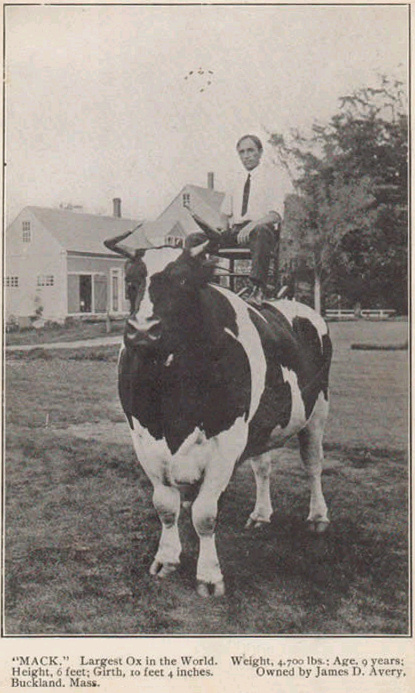
"Mack." the largest Ox in the world.
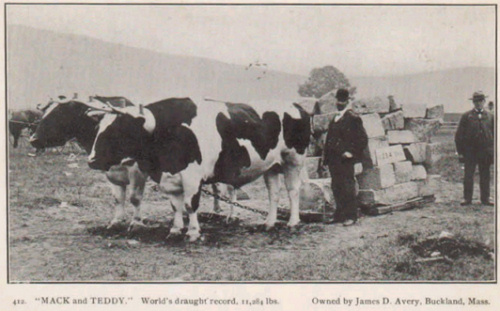
James Avery's bulls, Mack and Teddy
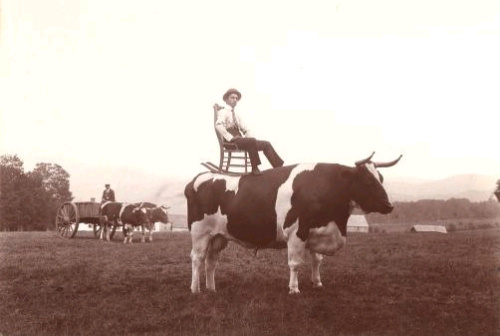
Jim Avery on one of his large oxen, 1900.
Note the Carter Farm in the background.
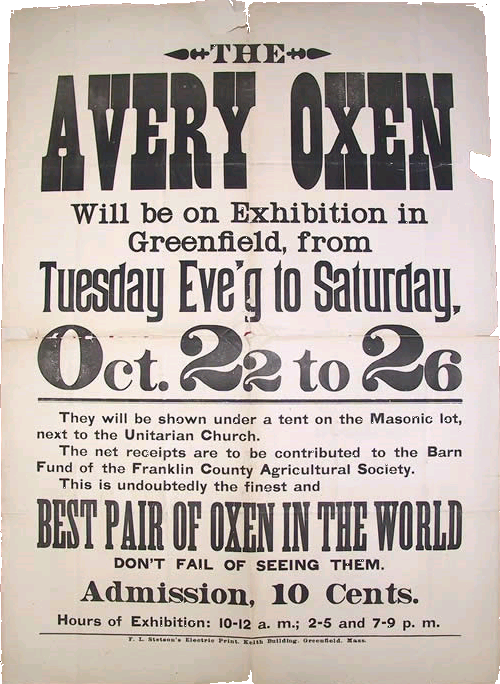
Courtesy of Buckland Historical Society
ADDENDUM:
In the late 1800s the Carter farm was originally owned by Jim Avery the owner of the famous huge oxen (see photos above). Because the soil was so much better down in the valley he moved, some time in the early 1900s, down to a farm near Clesson Brook on the flat lands near the old Buckland Train Station. The farm was purchased then by Mr. Carter. My father, Mark, Sr. used to work as a farm hand on the Avery farm prior to entering the army in about 1918. The road going by the above Carter farm is still known as "Avery Road."

